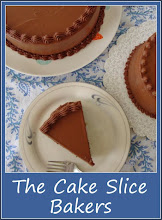 Tiramisu is a much loved classic Italian dessert and one that now appears on restaurant menus worldwide. When done right it can be wonderful - layers of coffee soaked Savoiardi Biscuits, thick mascarpone, Marsala wine and a light dusting of cocoa. Unfortunately all too often restaurants and shops take shortcuts, using sponge in place of the traditional biscuits and whipped cream instead of the pricier mascarpone and with only a hint of coffee. These poor standards bear no resemblance to a traditional Tiramisu and so I was thrilled when this month’s challenge was announced.
Tiramisu is a much loved classic Italian dessert and one that now appears on restaurant menus worldwide. When done right it can be wonderful - layers of coffee soaked Savoiardi Biscuits, thick mascarpone, Marsala wine and a light dusting of cocoa. Unfortunately all too often restaurants and shops take shortcuts, using sponge in place of the traditional biscuits and whipped cream instead of the pricier mascarpone and with only a hint of coffee. These poor standards bear no resemblance to a traditional Tiramisu and so I was thrilled when this month’s challenge was announced.The February 2010 Daring Bakers’ challenge was hosted by Aparna of My Diverse Kitchen and Deeba of Passionate About Baking. They chose Tiramisu as the challenge for the month. Their challenge recipe is based on recipes from The Washington Post, Cordon Bleu at Home and Baking Obsession.

On reading the recipe I started to feel a little daunted about the challenge. The description and recipe filled 6 pages and consisted of not one, not two, not even three separate compulsory components – there were four! Each of which was its own challenge in itself. We had to make:
1) Our own Savoiardi biscuits – more commonly known as Ladyfingers
2) A Zabaglione flavoured with Marsala Wine – another Italian classic
3) Vanilla pastry cream
4) Even our own Mascarpone cheese!
Despite feeling daunted, I could also feel a leap of excitement building inside of me. Here was a proper test-your-skills get-the-adrenalin-going challenge. I could see this recipe meant business and I was eager to conquer it.
The hosts chose pastry chef Carminantonio Iannaccone’s recipe for Tiramisu which is a little different from some other Tiramisu recipes as it includes a zabaglione that is also lightly cooked. This was good as it meant there was no risk to any DB members from using raw eggs. The recipe also required us to make a vanilla pastry cream to combine with the zabaglione and mascarpone to form the cream for the layers, much more decadent, and Italian, than using plain whipped cream.

We were also strictly banned from using sponge for our soaking layer, and had to make the authentic Savoiardi biscuits. These turned out to be much simpler than I expected and the results were incredibly light and airy. Completely different to the brittle shop bought biscuits I must admit I have used in the past. They were studded with airy holes which soaked up the boozy rum spiked coffee liquid they are dunked in.

The longest part was making the mascarpone as this requires chilling overnight, but once this was done I got all the other components made, baked, assembled, chilled and eaten in one day and had a whale of a time in the process. It was so much fun seeing each individual component coming together and then assembling them into the finished dessert. Tiramisu is usually made in a large square dish which is then cut into portions to serve. However, on the day I decided to make the tiramisu we were having guests to dinner, so instead I though it would be nice to make and present them in individual glasses which I think makes them look far more elegant like for a dinner party and allows the various layers to be seen through the sides of the glass. Plus it allowed me to get arty with some strips of card and the cocoa powder for decoration, making each one unique.

While making the different components I was quite surprised to find that most of them included a little lemon zest. This seemed an odd thing to add to a coffee dessert, but I went with it and hoped for the best. When I tasted the finish dessert I was pleased to find that I couldn’t detect an obvious lemon flavour but there was a fresh, vibrant flavour to the dish that I’m sure was thanks to the lemon, like when you add a little salt to baked goods to enhance the flavour. The Tiramisu also includes quite a lot of booze – Marsala wine in the Zabaglione and Rum in the coffee soaking liquid. I thought these might be a bit overpowering or fight with each other and the coffee for prominence but I needn’t have worried.

Eating a spoonful of the tiramisu certainly resulted in a bitter coffee boozy taste, but no one flavour overpowered the others, they all seemed to meld together into one heady rounded grown up flavour, with the fresh creamy mascarpone layer swooping in to sooth your taste buds in readiness for the next bite.

After dinner I couldn’t wait to taste my first mouthful and see if all the effort had been worthwhile. Tiramisu translates as ‘Pick Me Up’ in Italian and I have to say this Tiramisu didn’t just pick me up, it had me and my guests letting out sighs of enjoyment and grinning at each other in delight. It’s sublime – the best Tiramisu I have ever tasted. I feel no shame is stating this – it’s the recipe and individually flavoured components that made it so fantastically wonderful, I just followed the instructions and put them together. It’s boozy with a strong coffee hit, the layers of Savoiardi biscuits adding just a little resistance and lightness against the thick creamy indulgent mascarpone/zabaglione/pastry cream layer all finished with a dusting of bitter cocoa powder.
Yes it involved some work, but the results are definitely worth it. Next time you have a few free hours and want to make a show stopping dessert – do give this recipe a go – it’s utterly divine!
Click to see my fellow Daring Bakers and their Tiramisu’s.
Ultimate Tiramisu
 Mascarpone Cheese – needs making the day before
Mascarpone Cheese – needs making the day before(Vera’s Recipe for Homemade Mascarpone Cheese)
Ingredients
475ml pasteurized whipping cream (not ultra-pasteurized)
1 tablespoon fresh lemon juice
Method – Mascarpone Cheese
Bring 1 inch of water to a boil in a wide pan. Reduce the heat to medium-low so the water is barely simmering. Pour the cream into a medium heat-resistant bowl, then place the bowl into the pan. Heat the cream, stirring often, until it reaches 90C. If you do not have a thermometer, wait until small bubbles keep trying to push up to the surface.
It will take about 15 minutes of delicate heating.
Add the lemon juice and continue heating the mixture, stirring gently, until the cream curdles. The whipping cream will become thicker, like a well-done crème anglaise. It will cover a back of your wooden spoon thickly. You will see just a few clear whey streaks when you stir. Remove the bowl from the water and let cool for about 20 minutes.
Meanwhile, line a sieve with four layers of dampened cheesecloth and set it over a bowl. Transfer the mixture into the lined sieve. Do not squeeze the cheese in the cheesecloth or press on its surface (be patient, it will firm up after refrigeration time). Once cooled completely, cover with clingfilm and refrigerate (in the sieve) overnight or up to 24 hours.
Keep refrigerated and use within 3 to 4 days. This recipe makes around 350g of mascarpone cheese.
Note: The first time you make mascarpone you may not believe it will be cooked enough, because of its custard-like texture. However, have no fear, it firms up in the fridge yet remains lusciously creamy.
Ladyfingers/ Savoiardi Biscuits
(Recipe from Cordon Bleu At Home)
 Ingredients
Ingredients3 eggs, separated
75g caster sugar
85g plain flour
10g cornflour
50g icing sugar
Method
Preheat your oven to 175C and line two baking sheets with parchment paper.
Beat the egg whites using a hand held electric mixer until stiff peaks form. Gradually add the caster sugar and continue beating until the egg whites become stiff again, glossy and smooth.
In a small bowl, beat the egg yolks lightly with a fork and fold them into the meringue, using a wooden spoon. Sift the flour and cornflour over this mixture and fold gently until just mixed. It is important to fold very gently and not overdo the folding. Otherwise the batter would deflate and lose volume resulting in ladyfingers which are flat and not spongy.
Fit a pastry bag with a large plain tip and pipe the batter into 5inch/12cm long strips leaving about 1inch/3cm space in between each one.
Sprinkle half the icing sugar over the ladyfingers and wait for 5 minutes. The sugar will pearl or look wet and glisten. Now sprinkle the remaining sugar. This helps to give the ladyfingers their characteristic crispness.
Hold the parchment paper in place with your thumb and lift one side of the baking sheet and gently tap it on the work surface to remove excess sprinkled sugar.
Bake the ladyfingers for 10 minutes, then rotate the sheets and bake for another 5 minutes or so until the puff up, turn lightly golden brown and are still soft.
Allow them to cool slightly on the sheets for about 5 minutes and then remove the ladyfingers from the baking sheet with a metal spatula while still hot, and cool on a rack.
Store them in an airtight container until required.
This recipe makes approximately 24 large or 45 small ladyfingers.
Tiramisu Components
(Carminantonio's Tiramisu from The Washington Post, July 11 2007 )
 Zabaglione
Zabaglione2 large egg yolks
50g caster sugar
60ml Marsala wine
½ tsp vanilla extract
½ tsp finely grated lemon zest
Vanilla Pastry Cream
55g caster sugar
1 tbsp plain flour
½ tsp finely grated lemon zest
½ tsp vanilla extract
1 large egg yolk
175ml whole milk
Whipped Cream
235ml chilled double cream
½ tsp vanilla extract
To Assemble the Tiramisu
(I thought only 1teaspoon of rum was a little stingy so I used 420ml coffee and 50ml rum)
470ml brewed espresso, warmed
1 tsp rum
110g caster sugar
75g mascarpone cheese (recipe above – I used 125g)
36 savoiardi/ ladyfinger biscuits (recipe above)
Cocoa powder for dusting
Method - Zabaglione
 Heat some water in a double boiler or place a pot with about an inch of water in it on the stove. Place a heat-proof bowl in the pot making sure the bottom does not touch the water.
Heat some water in a double boiler or place a pot with about an inch of water in it on the stove. Place a heat-proof bowl in the pot making sure the bottom does not touch the water.In a large glass or metal mixing bowl mix together the egg yolks, sugar, Marsala, vanilla extract and lemon zest. Whisk together until the yolks are fully blended and the mixture looks smooth.
Transfer the mixture to the top of a double boiler and cook the mixture over low heat, stirring constantly, for about 8 minutes or until it resembles thick custard (mine took more like 12minutes).
Once thick, remove from the heat, transfer the mixture to a small bowl and allow to cool to room temperature. Cover and refrigerate at least 4 hours or overnight, until thoroughly chilled.
Method - Pastry Cream
 Mix together the sugar, flour, lemon zest and vanilla extract in a medium heavy-bottomed saucepan. Add the egg yolk and half the milk and whisk until smooth.
Mix together the sugar, flour, lemon zest and vanilla extract in a medium heavy-bottomed saucepan. Add the egg yolk and half the milk and whisk until smooth.Now place the saucepan over low heat and cook, stirring constantly to prevent the mixture from curdling.
Add the remaining milk a little at a time, still stirring constantly. After about 12 minutes the mixture will be thick, free of lumps and beginning to bubble.
Transfer the pastry cream to a bowl and cool to room temperature. Cover and refrigerate at least 4 hours or overnight, until thoroughly chilled.
Method - Whipped Cream
Combine the cream and vanilla extract in a mixing bowl. Beat with an electric hand mixer until the mixture holds fairly stiff peaks. Set aside.
Method - To Assemble the Tiramisu
 Mix together the warm espresso, rum and sugar in a shallow dish, set aside to cool slightly.
Mix together the warm espresso, rum and sugar in a shallow dish, set aside to cool slightly.Once you have your marscapone, ladyfingers, pastry cream, zabaglione, whipped cream and coffee dipping liquid done you are ready to start assembling your tiramisu.
Have ready a rectangular serving dish about 8inches/20cm square ready to hand.
In a large bowl, beat the mascarpone cheese with a spoon to break down the lumps and make it smooth and easier to fold. Add the prepared and chilled zabaglione and pastry cream, mixing until just combined. Gently fold in the whipped cream. Set aside.
Now to start assembling the tiramisu.
Workings quickly, dip 12 of the ladyfingers in the sweetened espresso, about 1 second per side, no longer or else they will start to disolve and break up. They should be moist but not soggy. Immediately transfer each ladyfinger to the platter, placing them side by side in a single row. You may break a lady finger into two, if necessary, to ensure the base of your dish is completely covered. Drizzle over a little extra of the coffee rum mix.
Spoon one-third of the cream mixture on top of the ladyfingers, then use a rubber spatula or spreading knife to cover the top evenly, all the way to the edges.
Repeat to create 2 more layers, using around 12 ladyfingers and the cream mixture for each layer, ending with a final layer of cream. Cover the dish carefully with clingfilm and refrigerate the tiramisu for at least 4 hours or overnight.
To serve, sprinkle the tiramisu with cocoa powder dusted through a fine-mesh strainer. Cut into individual portions and serve.
Serves 6
Note: This recipe also works very well when divided between 6 individual serving glasses. Just layer them up as you would for a big one.





 For the Cake (brownie)
For the Cake (brownie) In a medium bowl combine the icing sugar and the cocoa powder and stir to mix well. Add the melted butter, milk and vanilla and beat everything together well. Set aside until the cake is done.
In a medium bowl combine the icing sugar and the cocoa powder and stir to mix well. Add the melted butter, milk and vanilla and beat everything together well. Set aside until the cake is done.




 Ingredients
Ingredients

 I have recently been experimenting with replacing some of the butter in cake mixes with buttermilk. I have found it results in a slightly denser, more fudgy yet moister cake. You don’t always want fudgy cupcakes but for a chocolate Valentines themed cake it’s perfect. When topped with a swirl of pink raspberry buttercream and a scattering of cute teeny tiny heart sprinkles it is a sweet treat emulating love and romance. A combination of fudgy chocolate base with sweet and creamy frosting finished with a hint of fruitiness. Go ahead and bake some for your friends or loved ones and whatever you do this weekend for Valentines, I hope it’s a happy one.
I have recently been experimenting with replacing some of the butter in cake mixes with buttermilk. I have found it results in a slightly denser, more fudgy yet moister cake. You don’t always want fudgy cupcakes but for a chocolate Valentines themed cake it’s perfect. When topped with a swirl of pink raspberry buttercream and a scattering of cute teeny tiny heart sprinkles it is a sweet treat emulating love and romance. A combination of fudgy chocolate base with sweet and creamy frosting finished with a hint of fruitiness. Go ahead and bake some for your friends or loved ones and whatever you do this weekend for Valentines, I hope it’s a happy one. Chocolate Raspberry Buttermilk Cupcakes
Chocolate Raspberry Buttermilk Cupcakes



 Ingredients
Ingredients



 Hazelnut Cake
Hazelnut Cake Place the water and caster sugar together in a small pan. Heat gently, stirring often, until the sugar has dissolved. Then allow the liquid to bubble and take on a light golden caramel colour. You don’t want it too dark.
Place the water and caster sugar together in a small pan. Heat gently, stirring often, until the sugar has dissolved. Then allow the liquid to bubble and take on a light golden caramel colour. You don’t want it too dark.





